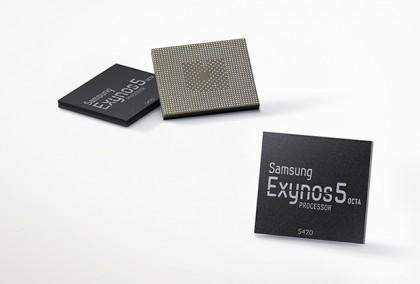 Samsung has unveiled Exynos 5 Octa, its latest top-of-the-range smart device processor saying it offers more than twice the 3D graphics power of its predecessor.
Samsung has unveiled Exynos 5 Octa, its latest top-of-the-range smart device processor saying it offers more than twice the 3D graphics power of its predecessor.
The Exynos 5 Octa is the first production-ready chip to include ARM Holding’s latest GPU (graphics processing unit) architecture.
Samsung’s move to license the tech marks a reversal of its decision to use a GPU design by rival British chip firm Imagination in the last version.
In its press release Samsung highlighted the fact that GPUs are increasingly being used to handle general computing tasks and not just video games graphics. It enters mass production next month.
While GPUs are typically slower at doing single calculations than CPUs (central processing units), they have the advantage that they carry many of them simultaneously.
This makes them particularly adept at handling highly “parallelisable” tasks such as applying filters to photographs, running augmented reality apps as well as speech, gesture and facial recognition.
Power efficiency
While the vast majority of smart devices use ARM-designed CPUs, the firm is a smaller player when it comes to GPUs.
In February the Cambridge-based business said it accounted for about 20% of all Android phones and 50% of Android tablets. Apple’s iOS devices use Imagination’s GPU tech.
Swapping one company’s mobile GPU design for another is relatively easy as the companies behind them all work to the same open standards.
The Exynos 5 Octa features six ARM Mali T628 GPU cores. The chip can activate more or fewer of them depending on the complexity of a task, allowing devices to minimise power use at times when most of the cores are not needed.
“Consumers want increased functionality on their device, but battery technology hasn’t increased at the same rate,” a spokesman for ARM told the BBC. “Therefore power efficiency is key.”
The chip also uses four of ARM’s high-powered A15 CPU cores and four of its weaker A7 CPU cores, with the “big-little” combination again designed to allow devices to alter which parts are used to extend battery life.
Samsung says the CPU cores offer a 20% speed boost over those in the earlier Exynos 5410, used to power the UK version of its Galaxy S4 handset.
Chip competition
In addition to using Exynos chips in most of its own Galaxy-branded products, Samsung has also sold them for use in phones and tablets sold by Lenovo, Hyundai and others.
It says the new chip will be powerful enough to offer “desktop-quality” video editing and support 1080p high definition video playback at 60 frames per second.
But the South Korean company faces competition from US firms Nvidia and Qualcomm which are now offering mobile chips capable of supporting the 4K ultra high definition video format.
Intel’s new chief executive, Brian Krzanich, has also said his firm plans to accelerate development of its low power Atom chips. Samsung recently took the surprising step of including one of the components in its Galaxy Tab 3 10.1 tablet.
Google’s Motorola unit has just announced it is introducing its own chip – called the X8 mobile computing system – for use in its latest handsets. There are reports, though, that this may merely be a tweaked Qualcomm product.
However, another firm, Texas Instruments – which had provided chips for some of Amazon’s Kindle tablets – announced last year it would stop investing in the sector because of the high level of competition.
“Samsung has generally done very well at walking the difficult line of being a manufacturer of components – including memory as well as processors – as well as making devices, which can put it head-to-head with the people it is selling parts to,” said Chris Green, principal technology analyst at consultants Davies Murphy Group.
“Whilst it’s almost certain the primary customer for the new chip will be Samsung itself, the firm will also be looking to maximise on its investment by selling the technology to other manufacturers including big name brands as well as lesser known ones who produce unbranded devices or goods for others.”
………………
As reported by BBC Tech

